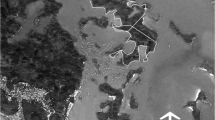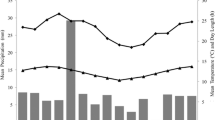Abstract
Activity patterns and time budgets are 2 important aspects of animal behavior that researchers use to investigate ecological influences on individual behavior. We collected data on activity patterns and time budgets in 1 group of François’ langurs (Trachypithecus francoisi) from August 2003 to July 2004 in the Nonggang Nature Reserve, Guangxi Province, China, via instantaneous scan sampling method with 15-min intervals. The diurnal activity pattern of François’ langurs showed morning and afternoon feeding peaks, with a midday resting peak. Seasonal change was apparent in the activity pattern: 2 significant feeding peaks occurred in the dry season and only 1 significant feeding peak in the rainy season. The group spent an average of 51.5% of the daytime resting. Feeding and moving accounted on average for 23.1% and 17.3% of the activity budget, respectively. Subjects spent little time on social activities, averaging 2% for grooming and 5.5% for playing. Their time budgets showed significant seasonal variation: they spent a greater proportion of time on feeding and less time on resting and grooming in the dry season than in the rainy season. They also differed among different sex-age classes: immatures spent more time playing, whereas adults devoted more time to resting, feeding, and grooming. Correlations between time budgets and food items or food availability clearly indicated that François’ langurs might adopt an energy-maximizing strategy when preferred foods were scarce in the dry season.




Similar content being viewed by others
References
Altmann, J. (1974). Observational study of behavior: Sampling methods. Behavior, 49, 227–262.
Bocian, C. M. (1997). Niche separation of black-and-white Colobus monkeys (Colobus angolensis and C. guereza) in the Ituri Forest. Ph.D. Thesis, The City University of New York.
Bravo, S. P., & Sallenave, A. (2003). Foraging behavior and activity patterns of Alouatta caraya in the northeastern Argentinean flooded forest. International Journal of Primatology, 24, 825–846.
Bronikowski, A. M., & Altmann, J. (1996). Foraging in a variable environment: Weather patterns and the behavioral ecology of baboons. Behavioral Ecology and Sociobiology, 39, 11–25.
Chivers, D. (1977). The feeding behaviour of siamang (Symphalangus syndactylus). In Clutton-Brock, T. H. (ed.), Primate ecology: Studies of feeding and foraging behaviour in lemurs, monkeys, and apes (pp. 355–383). London: Academic Press.
Clutton-Brock, T. H. (1974). Activity patterns of red colobus (Colobus badius tephrosceles). Folia Primatologica, 21, 161–187.
Clutton-Brock, T. H. (1977a). Appendix 1: methodology and measurement. In Clutton-Brock, T. H. (ed.), Primate ecology: Studies of feeding and raging behavior in lemurs, monkeys, and apes (pp. 585–590). London: Academic Press.
Clutton-Brock, T. H. (1977b). Some aspects of intraspecific variation in feeding and ranging behavior in primates. In T. H. Clutton-Brock (ed.), Primate ecology: Studies of feeding and foraging behaviour in lemurs, monkeys, and apes (pp. 539–556). London: Academic Press.
Clutton-Brock, T. H., & Harvey, P. H. (1977). Species differences in feeding and ranging behaviour in primates. In T. H. Clutton-Brock (ed.), Primate ecology: Studies of feeding and foraging behaviour in lemurs, monkeys, and apes (pp. 557–584). London: Academic Press.
Dasilva, G. L. (1992) The western black-and-white colobus as a low-energy strategist: Activity budgets, energy expenditure and energy intake. Journal of Animal Ecology, 61, 79–91.
Den, Z. Q. (1988). Report on the investigation of karst geology from Nonggang Nature Reserve. Guihaia 1(Suppl), 1–16 (in Chinese).
Di Fiore, A., & Rodman, S. (2001). Time allocation patterns of lowland woolly monkeys (Lagothrix lagotricha poeppigii) in a neotropical terra firma forest. International Journal of Primatology, 22, 449–480.
Ding, W., & Zhao, Q. K. (2004). Rhinopithecus bieti at Tacheng, Yunnan: Diet and daytime activities. International Journal of Primatology, 25, 583–598.
Doran, D. (1997). Influence of seasonality on activity patterns, feeding behavior, ranging, and grooming patterns in Taï chimpanzees. International Journal of Primatology, 18, 183–206.
Dunbar, R. I. M. (1992). Time: A hidden constraint on the behavioural ecology of baboons. Behavioral Ecology and Sociobiology, 31, 35–49.
Dytham, C. (1999). Choosing and using statistics: A biologist’s guide. Oxford: Blackwell Science.
Fashing, P. J. (2001). Activity and ranging patterns of guerezas in the Kakamega forest: Intergroup variation and implications for intragroup feeding competition. International Journal of Primatology, 22, 549–577.
Groves, C. (2001). Primate taxonomy. Washington, DC: Smithsonian Institution Press.
Halle, S., & Stenseth, N. C. (2000). Activity patterns in small mammals, an ecological approach. Heidelberg: Springer-Verlag.
Hanya, G. (2004). Seasonal variations in the activity budget of Japanese macaques in the coniferous forest of Yakushima: Effects of food and temperature. American Journal of Primatology, 63, 165–177.
Harding, R. S. O. (1976). Ranging patterns of a troop of baboon (Papio anubis) in Kenya. Folia Primatologica, 25, 143–185.
Hemingway, C. A. (1999). Time budgets and foraging in a Malagasy primate: Do sex differences reflect reproductive condition and female dominance? Behavioral Ecology and Sociobiology, 45, 311–322.
Hill, R. A. (1999). Ecological and demographic determinants of time budgets in baboons: Implications for cross-populational models of baboon socioecology. Ph.D. thesis, University of Liverpool.
Hill, R. A., Weingrill, T., & Barrett, L. (2004). Indices of environmental temperatures for primates in open habitats. Primates, 45, 7–13.
Huang, C. M., Wei, F. W., Li, M., Li, Y. B., & Sun, R. Y. (2003). Slee** cave selection, activity pattern and time budget of the white-headed langur. International Journal of Primatology, 24, 825–846.
Huang, J. T., Huang, L. B., and Guo, Y. R. (1983). Ecology of François’ langurs. Wildlife, 4, 11–12 (in Chinese).
Janson, C. H., & Goldsmith, M. L. (1995). Predicting group size in primates: Foraging costs and predation risks. Behavioral Ecology, 6, 325–336.
Lawes, M. J., & Piper, S. E. (1992). Activity patterns in free-ranging Samango monkeys (Cercopithecus mitis erythrarchus Perters, 1852) at the southern range limit. Folia Primatologica, 59, 186–202.
Li, Z. Y. (1993). Preliminary investigation of the habitats of Presbytis françoisi and Presbytis leucocephalus, with notes on the activity pattern of the Presbytis leucocephalus. Folia Primatologica 60, 83–93.
Li, M. J., & Ma, J. Z. (1989). Preliminary investigation of ecology and population of Presbytis francoisi in Mayanghe Nature Reseve. Wildlife, 4, 13–15 (in Chinese).
Li, Z. Y., & Rogers, E. (2004). Habitat quality and time budgets of white-headed langurs in Fusui, China. International Journal of Primatology, 25, 41–54.
Marsh, C. W. (1981). Time budget of Tana River red colobus. Folia Primatologica 35, 35–50.
Matsumoto-Oda, A., & Oda, R. (2001). Activtiy budgets of wild female chimpanzees in different reproductive states. Journal of Ethology, 19, 17–21.
Mckey, D. B., & Waterman, P. G. (1982). Ranging behavior of a group of black colobus (Colobus satanas) in the Dauala-Edea Reserve, Cameroon. Folia Primatologica, 39, 264–304.
Muruthi, P., Altmann, J., & Altmann, S. (1991). Resource base, parity, and reproductive condition affect females’ feeding time and nutrient intake within and between groups of a baboon population. Oecologia, 87, 464–472.
Oates, J. F. (1977). The guereza and its food. In Clutton-Brock, T. H. (ed.), Primate ecology: Studies of feeding and foraging behaviour in lemurs, monkeys, and apes (pp. 275–321). London: Academic Press.
Oates, J. F. (1987). Food distribution and foraging behavior. In Smuts, B. B., Cheney, D. L., Seyfarth, R. M., Wrangham, R. W., & Struhsaker, T. T. (ed.), Primate societies (pp. 197–209). Chicago: University of Chicago Press.
Oates, J. F. (1994). The natural history of African colobines. In A. G., Davies, & J. F., Oates (eds.), Colobine monkeys: Their ecology, behaviour and evolution (pp. 75–128.). Cambridge, UK: Cambridge University Press.
O’Brien, T. G., & Kinnaird, M. F. (1997). Behavior, diet, and movements of the Sulawesi crested black macaque (Macaca nigra). International Journal of Primatology, 18, 321–351.
Passamani, M. (1998). Activity budget of Geoffroy’s marmoset (Callithrix geoffroyi) in an Atlantic forest in southeastern Brazil. American Journal of Primatology, 46, 333–334.
Poulsen, J. R., Clark, C. J., & Smith, T. B. (2001). Seasonal variation in the feeding ecology of the grey-cheeked mangabey (Lophocebus albigena) in Cameroon. American Journal of Primatology, 54, 91–105.
Post, D. G. (1981). Activity patterns of yellow baboons (Papio cynocephalus) in the Amboseli National Park, Kenya. Animal Behavior, 29, 357–374.
Richard, A. F. (1977). The feeding behaviour of Propithecus verreauxi. In Clutton-Brock, T. H. (ed.), Primate ecology: Studies of feeding and foraging behaviour in lemurs, monkeys, and apes (pp. 72–96). London: Academic Press.
Richard, A. F. (1985). Primates in nature. New York: W. H. Freeman.
Schoener, T. W. (1971). Theory of feeding strategies. Annual Review of Ecological Systems, 2, 369–404.
Shu, Z. M., Zhao, T. L., & Huang, Q. C. (1988). Vegetation survey in Nonggang Nature Reserve. Guangxi Botany (Suppl), 1, 185–214 (n Chinese).
Stanford, C. B. (1991). The capped langur in Bangladesh: Behavioral ecology and reproductive tactics. Basel: S. Karger.
Starin, E. D. (1991). Socioecology of the Red Colobus Monkey in the Gambia with Particular Reference to Female-Male Differences and Transfer Patterns. Ph.D. Thesis, City University of New York, New York.
Strier, K. B. (1987). Activity budget of woolly spider monkeys, or muriquis (Brachyteles arachnoids). American Journal of Primatology, 13, 385–395.
Struhsaker, T. T. (1975). The red colobus monkey. Chicago: University of Chicago Press.
Teichroeb, J. A., Saj, T. L., Paterson, J. D., & Sicotte, P. (2003). Effect of group size on activity budgets of Colobus vellerosus in Ghana. International Journal of Primatology, 24, 743–758.
Waterman, P. G., & Kool, K. M. (1994). Colobine food selection and plant chemistry. In Davies, A. G., & Oates, J. F. (eds.), Colobine monkeys: Their ecology, behaviour and evolution (pp. 251–284). Cambridge, UK: Cambridge University Press.
Watts, D. P. (1988). Environmental influences on mountain gorilla time budgets. American Journal Primatology, 15, 195–211.
Whitten, P. L. (1983). Diet and dominance among female vervet monkeys (Cercopithecus aethiops). American Journal of Primatology, 5, 139–159.
Wu, M. C. (1983). On the distribution and number estimation of primates in Guangxi Province. Acta Theriologica Sinica, 3, 16. (in Chinese).
Yeager, C. P., & Kool, K. (2000). The behavioral ecology of Asian colobines. In Whitehead, P. F., & Jolly, C. J. (eds.), Old world monkeys (pp. 497–521). Cambridge, UK: Cambridge University Press.
Zhao, Q. K. (1999). Responses to seasonal changes in nutrient quality and patchiness of food in a multigroup community of Tibetan macaques at Mt. Emei. International Journal of Primatology, 20, 511–524.
Zhou, Q. H., Wei, F. W., Li, M., Huang, C. M., & Luo, B. (2006). Diet and food choice of Trachypithecus francoisi in the Nonggang nature reserve, China. International Journal of Primatology, 27, 1441–1460.
Acknowledgments
CAS Innovative Research International Partnership Project (CXTDS2005-4), National Science Fund for Distinguished Young Scholars (30125006) to F.-W Wei, and BP Conservation Programme (Bronze Award, 2003, UK) funded the project. We thank H.-S. Huang, S.-Y. Liu, X. Wang, and J.-Y. Bai for assistance in the field, and Prof. Z.-M. Shu, Guangxi Institute of Botany, Chinese Academy of Sciences, for identifying plant specimens. The Guangxi Forestry Bureau and Nonggang Nature Reserve Administration Bureau provided much assistance. We thank Prof. C. Groves for language editing, 2 anonymous reviewers for critical comments, and Dr.. R. H. Tuttle for careful editorial work.
Author information
Authors and Affiliations
Corresponding author
Rights and permissions
About this article
Cite this article
Zhou, Q., Wei, F., Huang, C. et al. Seasonal Variation in the Activity Patterns and Time Budgets of Trachypithecus francoisi in the Nonggang Nature Reserve, China. Int J Primatol 28, 657–671 (2007). https://doi.org/10.1007/s10764-007-9144-6
Received:
Revised:
Accepted:
Published:
Issue Date:
DOI: https://doi.org/10.1007/s10764-007-9144-6




